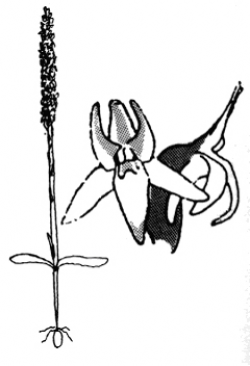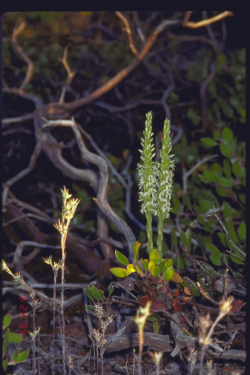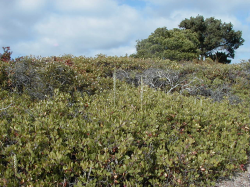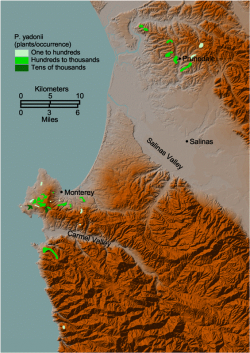
endangered

Illustration by R. Morgan.


Piperia yadonii habitat in maritime chaparral.




This fact sheet was prepared by Grey F. Hayes and Dean W. Taylor under award NA04N0S4200074 from the National Oceanic and Atmospheric Administration (NOAA), U.S. Department of Commerce (DOC). The statements, findings, conclusions, and recommendations are those of the authors and do not necessarily reflect the views of the NOAA or the DOC.
© Copyright 2006, Elkhorn Slough Coastal Training Program
Last updated: May 25, 2006 14:03
Common Names - Yadon's rein orchid
Family - Orchidaceae (Orchid Family)
State Status - none
Federal Status - federal endangered
(August 1998)
Habitat
Confined to three habitats: 1) maritime chaparral, with Hooker’s manzanita (Arctostaphylos hookeri ssp. hookeri); 2) Monterey pine (Pinus radiata) forest, sometimes with Gowen cypress (Hesperocyparis goveniana); 3) Monterey cypress (Hesperocyparis macrocarpa) forest. The populations in woodland communities occur under partial canopy cover in an open mostly herbaceous understory (Morgan and Ackerman 1990).
Associated soils are sandstone outcrops or shallow soils above granitic bedrock. On ancient marine terraces above decomposed granitic bedrock in forested communities, in highly leached and acidic soils, typically with a clay hardpan at variable depths.
Key Characteristics
Erect perennial herb from generally roundish tuber, 10–50(80) cm, single flowering stalk; leaves basal, 2–3, strap-shaped to lanceolate, 10–17 cm long, 20–39 mm wide in older plants, much smaller in young; inflorescence dense; flower fragrant in daytime, harsh to honey-like; upper sepal green with white margin, ± erect, lower white, midvein faintly green; lateral petals ± erect, sickle-shaped, green, white margins unequal, outer much wider than inner, lip 2.5-5 mm, lance-deltate, pointed down toward spur, white, spur 2.5-5 mm, pointed down (Ackerman and Lauri 2013).
Distinguished from the other Piperia species by having three green and white upper tepals and three pure white lower tepals. Flowers that appear very late in the season may lack any green color. Another important distinguishing characteristic is the characteristically short spur.The leaves of all but the largest plants wither by flowering time.
The range of P. yadonii overlaps with P. elegans, P. elongata, P. michaelii, and P. transversa and can only be reliably distinguished from them in flower. Published records of occurrence in mixed populations with P. elongata or P. elegans are known.
Flowering Period
June to August
Reference Populations
S.F.B. Morse Botanical Reserve, Manzanita County Park, The Nature Conservancy’s Blohm Ranch Nature Preserve (Monterey County).
Global Distribution
Endemic to California in northern Monterey County: Prunedale Hills, Monterey Peninsula, with the isolated southernmost population occurring on Rocky Creek Ridge (Cushing Mountain) in Big Sur.
Conservation
The primary threat to this species is habitat loss, although other significant threats include floral herbivory (deer, rabbits, possibly other small mammals and invertebrates), competition from nonnative plants, as well as habitat loss due to fire suppression. Habitat fragmentation may present a threat as the species requires pollination for optimal seed set and shows signs of inbreeding depression.
P. yadonii poses a number of difficulties to any monitoring effort. First, it is difficult to identify except during a brief flowering period. All populations need to be surveyed during flowering to determine whether other species of Piperia occur intermixed. Second, an unknown proportion of each population remains underground as dormant tubers in any given growing season, monitoring over a several-year period is suggested. Of the individuals that do emerge and leaf out in any given year, only a small percentage flower and there is strong variation in flowering rate between years, populations, and perhaps even habitats. Hence abundance is best tracked by counting individuals in leaf, since the leaves have senesced by the time flowering occurs. Dormancy and the difficulty in identifying the species except during flowering make it extremely difficult to track population dynamics or estimate population size (Wells and Willems 1991; Rasmussen 1995).
References
Ackerman, J. D. and R. Lauri. 2013. Piperia yadonii, in Jepson Flora Project (eds.). Jepson eFlora, http://ucjeps.berkeley.edu/cgi-bin/get_IJM.pl?tid=38361 [accessed 21 February 2015].
CNPS, Rare Plant Program. 2010. Piperia yadonii, in Inventory of Rare and Endangered Plants (online edition, v8-02). California Native Plant Society, Sacramento, CA. http://www.rareplants.cnps.org/detail/729.html [accessed 21 February 2015].
Morgan, R. and J. D. Ackerman. 1990. Two new piperias (Orchidaceae) from western north America. Lindleyana 5(4):205–211.
Rasmussen, H. N. 1995. Terrestrial Orchids from Seed to Mycotrophic Plant. Cambridge University Press, Cambridge, U.K.
U.S. Fish and Wildlife Service. 1998. Endangered and threatened wildlife and plants: Final rule listing five plants from Monterey County, CA, as endangered or threatened. Federal Register 63:43100–43116.
Wells, T. C. and J. H. Willems, eds. 1991. Population Ecology of Terrestrial Orchids. SPB Academic, The Hague, Netherlands.
